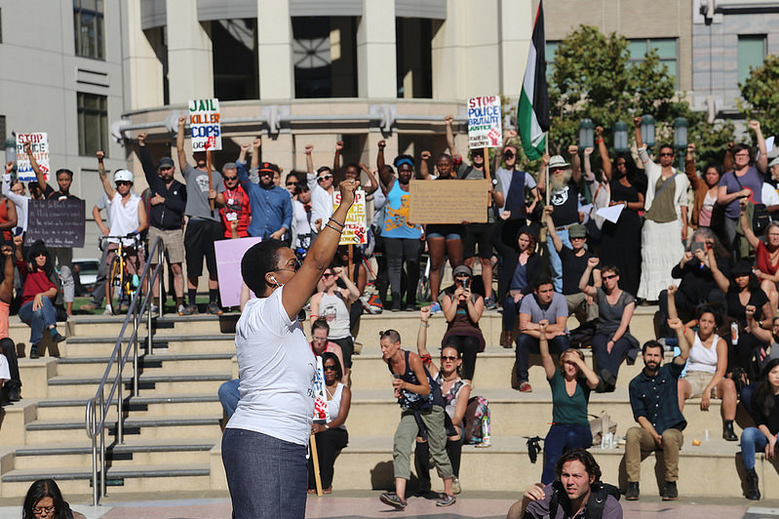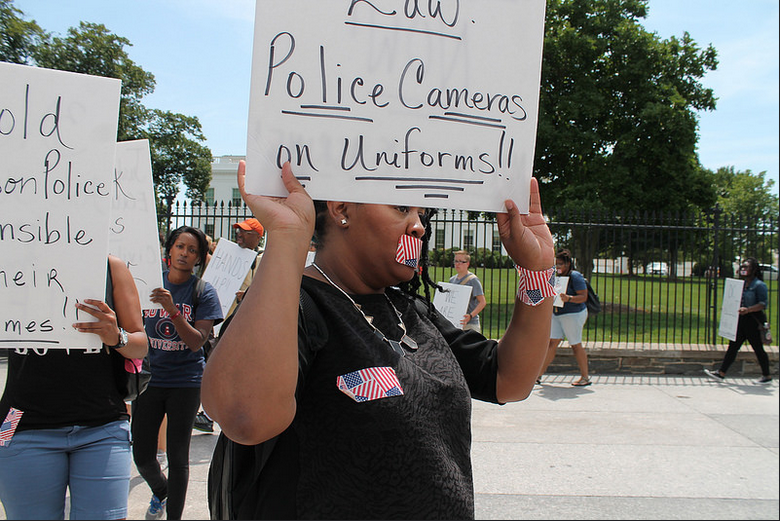
Photo: dakini / Flickr
In the nine days since the death of Michael Brown in the St. Louis suburb of Ferguson, Missouri, there have been two primary suggestions aimed at curbing excessive police action against civilians. The first calls for an examination of the federal government’s provision of military equipment to state and local police departments. Such criticism has been loud and even bipartisan: Rep. Hank Johnson (D-GA) introduced a bill that would limit such provisions, while Senator Rand Paul (R-KY) called police militarization “an unprecedented expansion of government power” in an impassioned TIME op-ed.
The second suggestion would mandate that police wear cameras while on duty: a Change.org petition calling for St. Louis area police to wear cameras has already drawn over 32,000 signatures, and in New York City, Public Advocate Letitia James argued for a camera program after Eric Garner’s death following an illegal chokehold by police.
Standing alone, neither of these suggestions is likely to succeed. At best, the federal program that facilitates police militarization (called “1033” from the section of the U.S. Code enabling it; see our companion piece on Ferguson for more) may be slowed and subjected to additional regulation, but it is highly doubtful that the tanks, armored carriers, and automatic weapons will ever be returned or relegated to a dusty garage. As Slate’s Jamelle Bouie noted, “When you give anyone toys, you have to expect they’ll play with them.”
Meanwhile, a direct federal requirement that police wear cameras in the line of duty would likely be struck down in the courts as unconstitutional federal meddling in local law enforcement.
So here’s a proposal: tether the two reforms. If a police department wants federal support, whether in funding, equipment, or both, then it must require its officers to wear cameras while on duty. Additional federal funding could be made available for studies, pilot projects, and purchasing the cameras themselves — although some of that burden should fall on the localities seeking the federal support. And given the astounding reach of 1033 and other federally-funded officer hiring programs to even rural communities and small towns, this approach would lead to camera programs being widely adopted throughout the US.
The first stage for the adoption of cameras — commissioning additional studies to confirm whether wearable cameras have any benefit — is long overdue. One California city carried out a much-reported experiment last year and found that camera usage reduced police complaints by 88% and use of force by 60%, but few other studies have been conducted. This needs to change immediately.
While the limited work on this initiative leaves open the question of whether the cameras actually affected the officers’ behavior — or instead affected the civilians the police encountered — that question is largely irrelevant. Some of the complaints may have been avoided because the officers knew they were being recorded, others because the civilians knew that they were being recorded. If the policy reduces both police misconduct and baseless complaints against police, do we really need to know the exact proportions? It’s a win-win either way.

Photo: perspective / Flickr
One of the most terrifying elements of any death like Brown’s is that there is never a definitive account of what happened. The local police in Ferguson claim that Brown assaulted an officer and tried to take his gun; an eyewitness claims that Brown was running away from officers when he was killed and that he was shot twice in the back. While forensic evidence may help settle this dispute, footage definitely would — and the presence of a live camera may have prevented Brown’s death altogether.
Plus there’s another critical selling point here. The possibility of a reduction in complaints and frivolous lawsuits against cops — not to mention the possible reduction in paperwork by eliminating the need to write up every encounter — should be emphasized as a reason for officers and their representatives to be open to reform. Similarly, reluctant lawmakers could be persuaded by the prospect that the cameras will ultimately pay for themselves in money saved from processing complaints, internal investigations, and lawsuits and settlements. And if further studies confirm the benefits of a camera requirement, results can trump rhetoric and natural resistance to change.
Tying strings to federal largesse is nothing new — and, critically, has been repeatedly upheld in court. For example, in a series of shifts during the ‘80s and ‘90s, states increased their drinking ages to 21 and lowered their blood alcohol limits to 0.08 in response to federal promises of funding, or threats of its denial. Louisiana was notoriously the last holdout on the drinking age; it finally capitulated after the Clinton administration stated that it would withhold $17 million in federal highway funds.
But what a counterargument that a camera requirement is only a half-measure and that a direct attack on police militarization is needed? Starting with cameras is more likely to succeed and would have a substantial impact. The creeping metastasis of the surveillance state and metamorphosis of what we used to call “peace officers” into soldiers are grave threats to democracy that will require vigilance and whatever opposition can be mustered against them. Mandating transparency is a necessary initial check on the paramilitary SWATization of local police. It will force any police department to think twice before accepting Uncle Sam’s gifts, and invariably some departments — perhaps some of the ones that really don’t need the gifts — will decide that getting a few new toys is not worth the trouble of implementing a camera program.
There will still be a likely benefit even for those departments that do accept the tradeoff. While all the battle-dress uniforms and armored vehicles may make officers more aggressive, cameras could bring moderation, a reminder that they’re in their own country, encountering their own fellow citizens, acting as public servants accountable to the laws rather than warriors in an occupying army. Even when military-grade equipment is appropriate — almost no one complained when such a show of force was used after the Boston Marathon bombings, for example — wearable cameras would be an embodiment of the Spiderman principle: with great power comes great responsibility.
As for concerns that a camera requirement would just mean more surveillance, there is a critical difference between wearable cameras and the private and governmental cameras that have proliferated across many cities: a police officer is already an agent of surveillance. Attaching a camera to an officer does not increase the surveillance; it increases the accuracy of the resulting record. It reduces the possibility of mistakes or maliciousness — particularly in the fast-moving situations that police work sometimes calls for, when events overtake the mind’s ability to process them. Cameras catch what the eye cannot. And when worn by an officer, they turn at least some of the state’s surveillance back onto itself.
Ultimately, though, requiring cameras is only the beginning. The root cause of the militarization of the police, including the 1033 program itself, was the War on Drugs—which is being increasingly called into question on a number of fronts, a process that must continue. And even deeper questions must be asked about the economic dynamics of the militarization itself: who profits when the military buys so much equipment that it can give away billions of dollars’ worth for free, a third of it never even used? These questions will take time to answer. In the meantime, we must try to deploy equipment that might save lives rather than end them.
·
 Tristan Snell is the co-publisher of The Brooklyn Quarterly.
Tristan Snell is the co-publisher of The Brooklyn Quarterly.
